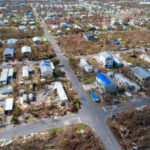Every property owner in North Carolina has a financial stake in the damage risk posed by Hurricane Irene, which could become the first to hit the state since a new method of paying for coastal storm damage allowed for reaching into the pockets of even those who suffer no losses.
Every North Carolina property owner has been on the hook for damage covered by the state’s coastal property insurance program since a sweeping change took effect in 2009. That’s when the General Assembly capped insurance company liability at $1 billion and made policy holders across the state shoulder a 10 percent surcharge on their insurance to cover a true catastrophe.
Hurricane Irene’s course Tuesday indicated a track that could carry it to landfall in the Carolinas this weekend.
“It hasn’t been an issue because we’ve had a mild storm season since the legislative changes were made. Now with Irene out there, this will probably start getting some attention,” said David Marlett, chairman of Appalachian State University’s Department of Finance, Banking, and Insurance.
The chances every property owner would be assessed a surcharge on their insurance policies is remote. It would take a storm among the top 10 costliest in U.S. history hitting in the state’s 18-county coastal zone before the owners of homes and businesses elsewhere would have to pay.
“It’s very unlikely,” Marlett said. “There’s a 1 percent chance it could be bigger than what they planned for, and that’s when they go to the rest of the state and ask them to contribute.”
Two years ago, state legislators were forced to confront the fact that the state-created coastal insurance plan, called the Beach Plan, was badly overcommitted. The plan insured 170,000 properties valued at nearly $74 billion in 18 coastal counties, but had the resources to cover just a fraction of that. Property insurers had to participate in the Beach Plan and their risks in addition to paying off their own policy holders were unknown and unlimited.
A few decided to quit doing business in North Carolina rather than take the chance they would be tapped to share the damages if a massive hurricane cleaned out the Beach Plan.
“Our concern with North Carolina was just unlimited liabilities that carriers would face at that point,” said Raymond Farmer, a Southeast vice president for the American Insurance Association, which represents major insurers. That association pushed for the change.
The solution directed the Beach Plan to build up its surplus, cap at $1 billion what insurance companies would pick up, and buy more catastrophe insurance.
The Beach Plan this spring said it was ready to handle up to $4 billion in wind losses before all property owners would pick up further rebuilding costs.
Hurricane Floyd hit North Carolina in 1996 and wind damage cost insurance companies about $1.8 billion when adjusted for inflation and other factors in 2009, according to the Insurance Information Institute. The total does not include flood losses, institute spokesman Mike Barry said.
Was this article valuable?
Here are more articles you may enjoy.

 Supplemental Claims Don’t Need to Include Damage Estimates, Fed Appeals Court Says
Supplemental Claims Don’t Need to Include Damage Estimates, Fed Appeals Court Says  4,800 Claims Handled by Unlicensed Adjusters in Florida After Irma, Lawsuit Says
4,800 Claims Handled by Unlicensed Adjusters in Florida After Irma, Lawsuit Says  UnitedHealth Data Leak May Affect ‘Substantial’ Swath of U.S.
UnitedHealth Data Leak May Affect ‘Substantial’ Swath of U.S.  South Carolina Allows Out-of-State Adjusters After Massive Hail Storm
South Carolina Allows Out-of-State Adjusters After Massive Hail Storm 